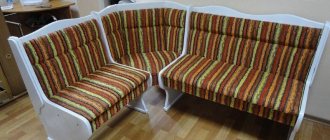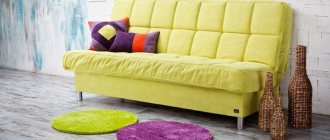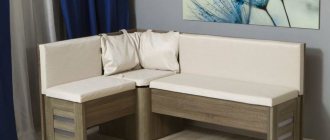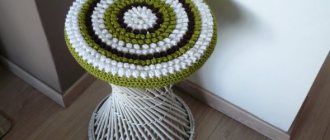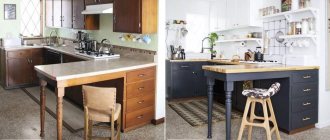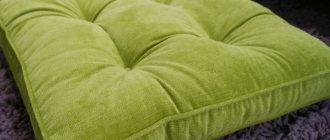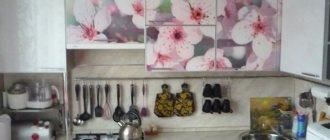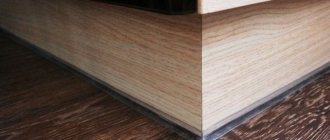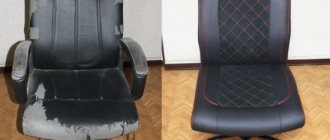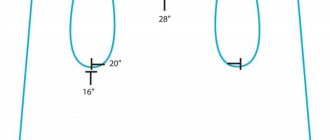Today, the kitchen in many apartments has become the most lived-in and favorite place: not only do the whole family have dinner here, but they often receive guests, conduct business conversations, and discuss the latest news with neighbors. That is why the kitchen corner, which decorates most kitchens, quickly loses its attractive appearance: the fabric on the seats wears out, becomes faded, and begins to tear. Structural elements become loose and unstable.
Although reupholstering furniture is considered a simple task, it is nevertheless important to have all the necessary tools at hand.
The kitchen corner, which decorates most kitchens, quickly loses its attractive appearance: the fabric on the seats wears out, becomes faded, and begins to tear.
Kitchen fumes also do their job, negatively affecting the strength of the material from which the seats and backs are made, as well as the condition of the filling. It gradually becomes saturated with moisture, falls off, loses softness and elasticity, which means the kitchen corner needs urgent help.
The kitchen corner, which decorates most kitchens, quickly loses its attractive appearance.
You can provide it by inviting a specialist who will carry out all the restoration and repair work. But it will bring great joy to the household if a home craftsman reupholsters the kitchen corner with his own hands.
Foam rubber is traditionally used as a filler when restoring kitchen corners.
Other tools may be needed to carry out restoration work, but their use will depend on their complexity.
About the restoration and types of repairs of kitchen corners
You can choose a new corner to suit every taste .
But frequent use in a room with high humidity and frequent temperature changes harms the furniture. Over time, food and liquids inevitably leave stains on the upholstery, and the fabric can fray and tear. And now, a few years later, we have before us a strong set, but one that has lost all its luster. The way out of this sad situation will be to reupholster the kitchen corner with new upholstery. The work can be entrusted to specialists, but independent repairs are also quite accessible at home for those who are not afraid and know how to work with their hands.
There are many advantages to reupholstering a soft corner with your own hands. Little skill is needed for such work, because the design is simple and the materials are available. Carrying out all the work yourself will save significant money. All materials can be selected to suit your taste. This is a great opportunity to gain and strengthen useful skills.
See also: Removing grain bugs from kitchen cabinets
Upholstered furniture has the main characteristics:
- coloring;
- design;
- size;
- configuration.
Several years of use wear down the surface of the soft corner, and the design becomes boring. In addition to simply reupholstering furniture, you often want to introduce some innovations into the interior. If you think about such changes in advance, you can easily make them a reality during the process of upholstery replacement.
Let's consider possible options for modernization at home:
- A fashionable option for finishing the back and seat in different colors. These can be contrasting shades or similar combinations. An extravagant combination of colored and plain is possible.
- Patchwork style upholstery. Different pieces of fabric are assembled into a geometric pattern of squares, triangles, stripes, or a chaotic pattern of shapeless shreds. The chaotic pattern is very beautiful, but requires serious sewing skills.
- Use of decorative elements such as buttons. This way you can emphasize the volume of the product and give it an original look.
- Changing the configuration of parts that are not subject to load. A job requiring some carpentry skills. Decorative parts are first cut out of plywood, then attached to the back and sides. The last stage is decorating.
- Adding armrests with soft, removable pads. Such a change will make the furniture more comfortable and bring something new to the decor. In addition, removable attachments are much easier to update than to do a full restoration of the sidewall.
Desk for two children: choosing the ideal option
But in most kitchens this is an extra element that simply won’t fit due to its size. It is much more logical and practical to make a corner compact design. A sofa bench works great here. This is a bench, often corner, with a convenient design, under which there are additionally hidden niches for various small items and kitchen utensils. They are the ones most often found on sale, and you can assemble them yourself. Finding assembly diagrams is not a problem at all these days. The main thing here is to take into account some nuances.
I’ll say right away that if you have a small kitchen, it’s better to transfer ideas and drawings with a folding design to the bedroom or living room.
In the kitchen you need a small sofa that will provide comfortable seating. It is not focused on constant sleep.
A kitchen sofa is usually angular or straight. A lot here depends on the shape and size of the kitchen itself, and how the furniture will be arranged.
There are a few key features to keep in mind before you start assembling it yourself.
- Height. Kitchen sofas are made higher than ordinary sofas for living rooms and bedrooms. If you've sat at a table on a regular sofa, you'll immediately understand what I'm talking about. Convenience will be questionable;
- Material of manufacture. We will talk about this separately later. But kitchen sofas are made only from practical materials that are easy to clean;
- Dimensions. They should be compact. Kitchens in the vast majority of cases are small and do not have a huge amount of space.
Now we will separately consider some issues related to self-assembly.
Fabric and other materials for updating the kitchen corner
When choosing a material for the restoration of a soft kitchen corner, focus on wear resistance and quality. Giving preference to beautiful colors without paying attention to the strength of the fabric is not the best solution.
To avoid having to update the corner every year, carefully study the range of furniture fabrics and choose the most optimal strength-beauty ratio. The stores will offer you many options; consider the most popular types of furniture fabric.
Tapestry
The most popular material for upholstering furniture. It demonstrates excellent wear resistance and strength. The range of tapestry colors is wide, so you can choose a beautiful material to suit any interior.
The tapestry is practical, which is especially important for the kitchen, and has long earned an excellent reputation.
Velours
The short, soft and dense pile of velor makes furniture with such upholstery especially stylish. It is pleasant to the touch, noble. The strength indicators of velor are quite good and with careful use it will last a long time.
The only negative noted by the owners is that the soft velor pile wears out in places with frequent use and the furniture loses its external luster.
Flock
Thick fabric with water-resistant impregnation. Housewives will especially appreciate flock, because it is easy to care for, washes well and lasts a long time. An unpretentious, wear-resistant and long-lasting option for thrifty people.
Jacquard
A beautiful and stylish material, but jacquard is not recommended for a kitchen corner. The fabric wears out quite quickly and is difficult to clean.
Chenille
The material is pleasant to the touch and affordable in price. A big advantage of chenille is its increased tear resistance. The material does not absorb odors and does not fade for a long time.
In addition to furniture fabric, leather and various modifications of this material are often chosen for the kitchen corner. Leather upholstery is easier to care for, looks rich and extravagant, and lasts a long time. Let's consider the options from which you can choose upholstery for the kitchen corner.
Addition. To decorate a corner upholstered in leather, use the carriage screed technique. Spectacular and rich furniture with similar decor symbolizes refined taste and wealth.
Genuine Leather
The most expensive and whimsical option. Without special skills, it is not recommended to work with this complex material; natural materials have their own characteristics. You should take on such work only if you are completely confident in your skills.
Skin requires special care and respect. She needs specialized cleaning products and should be protected from sharp objects and pets. But with proper care, genuine leather is very durable and does not lose its rich appearance for many years.
PU leather
Artificial material based on polyurethane. In terms of strength and abrasion resistance, it is slightly inferior to natural leather.
Soft, elastic and beautiful artificial leather of this variety will decorate furniture and will serve for a long time.
MF leather
If you decipher the letters in the name, this variety will immediately become well recognizable. Microfiber is made from the finest polyester fibers. This is a more expensive and functional material, it is closer to its natural counterpart.
Microfiber is moisture resistant, does not lend itself to abrasion for a long time and does not require complex care. Breathable microfibers make this upholstery especially comfortable. An excellent choice for kitchen furniture.
Eco leather
Two-layer artificial material. Fabric is used as a base, and the top layer consists of colored polyurethane. High-quality polymers that are used in the production of this type of artificial leather make it a hypoallergenic and safe material. Eco-leather is soft and pleasant to the touch, imitates natural leather well and is resistant to abrasion.
PVC leather
This material is made from polyvinyl chloride. The top layer is a one-sided monolithic or porous PVC applied to a fiber base. PVC leather is most often found in everyday life, since it is the most inexpensive and accessible artificial material. It is elastic, durable and easy to care for.
Its wear resistance characteristics are quite good, but there is one drawback - harmful substances. PVC production is not environmentally friendly; this factor can be decisive when choosing upholstery for kitchen furniture.
Textile or leather upholstery
Many people ask which kitchen upholstery is better - fabric or leather. These furniture fabrics differ both in price and in their performance characteristics. Among the advantages of textile upholstery is its amazing tactile qualities. This fabric is pleasant to the touch and looks very homely. In turn, leather has another undeniable advantage - it looks very elegant and presentable. But, unfortunately, the skin does not like temperature changes and can deteriorate as a result. Therefore, if the interior is primarily important to you in the kitchen and you don’t cook very often, feel free to choose leather upholstery. If you like to pamper your household with delicious pastries, it is better to choose fabric upholstery.
How to reupholster a kitchen corner correctly and beautifully with your own hands
Before updating the old kitchen corner, calculate the footage of the new material. The calculation includes the reserve required for unscheduled repairs of the largest fragment of the headset. The stock guarantees replacement in case of accidental damage to the upholstery, because the store may not have the required color. The cost of sofa cushions is also included immediately.
A standard kitchen set consists of a sofa, ottomans and a corner element. Each fragment is measured and the data is transferred to paper. On each side add 5 cm to the fold of the fabric. Calculations for fabric consumption are done in two ways.
Choose the one that is more practical and convenient for you personally:
- Make a layout of the pattern and lay it out on the fabric layout. Based on the width of the material in the roll, calculate the expected fabric consumption.
- Use an old sheet as a template. Place the removed old upholstery on fabric cut to the width of the material in the roll. Select the optimal cutting option. The filler is sold in meter sizes of 100x200 cm. This sheet of foam rubber is enough to repair a kitchen corner, but you need to take measurements. Choose the thickness of the material based on your preferences and furniture design.
To complete the work of reupholstering kitchen furniture, you will need tools. The selection of tools is approached with the utmost care.
Non-specialized equipment is not suitable for such work - the quality of the repair will suffer.
Tools:
- Furniture staple remover for removing old staples. A knife or wide screwdriver will also do this job, but a special device is more practical and convenient.
- Hammer.
- Painting or stationery knife.
- Keys for disassembling a wooden frame.
- Sewing machine.
- Furniture stapler.
- Additional fittings (if new decor is planned).
Materials needed:
- Fabric for new upholstery.
- Foam rubber for filling.
- Furniture cardboard for patterns.
- Fine soap or chalk.
- Glue for foam rubber.
- Varnish or paint for wooden parts.
Advice. If the design of the kitchen sofa has several identical removable pillows, number their bases. Often such seats, being out of place, do not coincide with the mounting points on the body.
Be sure to remove all fragile items from the kitchen and cover the floor and furniture with film. When disassembling a sofa, dust and dust spill out of the frame; it is better to foresee this in advance. Once everything is prepared and carefully thought out, you can begin to work.
If you decide to upholster your kitchen sofa and ottomans yourself, don’t rush. Accuracy, accurate calculations and adherence to instructions will ensure excellent results.
Step-by-step order of work:
- Remove the seats . Disassemble the sofa frame into its component parts using keys. Separate the box from the legs.
- Use an anti-stapler to remove old upholstery . Perform this step carefully so as not to damage the old casing. The parts will be needed to cut out the new upholstery.
- Carefully remove worn foam using a utility knife. Clean the parts from any remaining filler.
- Cut out new upholstery . At this stage, precision is needed, because if the new upholstery does not match the furniture, repairs will become problematic. Lay out the old parts on the straightened fabric and pin them with pins so that they do not move. If you are not confident in your sewing skills, you can make an initial pattern on paper or cardboard and draw the markings on the new fabric using a rigid shape. The marking is done with a thin piece of soap or chalk. On the pattern, make 5 cm of starting so that the fabric can be tucked freely and attached to the furniture.
- Sew ready-made templates on a sewing machine. It is recommended to go through the seams that bear the main load during operation several times. This will strengthen the covers.
- Cut out a soft base for the seats and back from foam rubber . Place new foam rubber on the cleaned frame. Secure it with construction glue.
- Try on sewn furniture covers . If necessary, adjust the pattern.
- Secure the upholstery to the body with a furniture stapler. The final stage is the most important. It is required to do the wrapping as carefully as possible so that the fabric does not bunch up or “wrinkle” anywhere. The staples must be firmly fixed to the wooden base at a distance of 4 cm. Rarely fastened fabric will soon turn outward and the furniture will have to be re-tightened.
- Wipe the wooden parts, dry them and cover them with fresh varnish or paint.
- Assemble the repaired parts onto the frame and secure them in place. If necessary, replace the fittings if they are loose or damaged.
The upholstery left over from the renovation can be used for decoration and to change the covers on the chairs. Paint old stools, update them by adding a soft seat, and cover them with new fabric. Just a few small changes in the decor - and the kitchen will look new and will delight you with a fresh design.
If you carefully prepare and carry out all the steps correctly, you will complete this work in 1-2 days.
Manufacturing process: step-by-step instructions
There are no minor parts in the manufacturing process
Every nuance is important, and therefore it is extremely important to follow the instructions and recommendations
If you are planning a long sofa, first cut out the necessary parts:
- bottom, plywood is suitable for making this part;
- bars for the frame part;
- sidewalls made of chipboard, 2 pieces required;
- side parts for the long sides of the box - you also need two parts, which can be made from plywood;
- back;
- sitting
It is very important to take clear measurements so that there are no problems when connecting the structure.
The next stage is assembly. You need to assemble the sofa in a certain order:
- The edges cover the ends of the sidewalls, and the bottom is covered with thrust bearings.
- Using a screwdriver and self-tapping screws, the frame is assembled, and then the box.
- The back is assembled and attached to the sides using dowels. You can strengthen the fastening using metal corners.
If it was planned to make a short sofa, then all actions will be similar. Only the size of the parts changes.
The most economical option is to use particle board or oriented strand board.
After the long and short sofas are ready, they are combined into one structure using a connecting element. Metal corners with the help of dowels attach the seat to the back, and then attach it to the side. The last stage is upholstery, if it is planned, of course.
If upholstery is not planned, then the wood can be treated with primer and varnish. To change the color, you can use tinting or paint.
Choosing the right material
Any material can be used to reupholster a kitchen corner. Restoration is especially useful for those who want to change the interior, add modern notes, and show imagination. Textile is the most popular upholstery material. You can choose the most suitable fabric in terms of color and characteristics. The most common include:
- Tapestry. Durable, attractive fabric. The advantages include long service life and a wide palette of colors.
- Velours. Very durable fabric. The downside is that over time the pile gets rubbed off, so it loses its presentable appearance.
- Flock. High-quality upholstery material, very durable, abrasion-resistant. Moisture-resistant impregnation will make it possible to easily wash and remove stains that often appear on furniture in the kitchen.
- Jacquard. A beautiful fabric, often used for furniture, but wears out quickly. Getting rid of dirty marks on it is quite problematic.
Tapestry
Jacquard
Flock Velor
Often, to renovate a kitchen corner, people choose artificial leather. Externally, as well as in properties, it is not inferior to natural, the cost is much less. The disadvantages include the fact that leatherette does not “breathe”. In addition, thin material will soon wear out, crack or tear, so it is necessary to select it correctly. It is optimal to use the following fabrics:
- PU leather. It is durable, resistant to damage, and heat resistant. This is possible thanks to the three-layer structure. The first is cotton, which gives softness and comfort. The second layer is genuine leather with some defects. The third is polyurethane, which gives the material the selected color and texture.
- MF leather. Not cheap, it can be difficult to distinguish it from natural one. Resistant to damage, odorless, highly water resistant. Thanks to this, stains from the surface are easily removed.
- Eco leather. The material is made from safe and environmentally friendly polyurethane. It will not provoke an allergic reaction. The main advantages include elasticity and odorlessness.
- PVC leather. Quite often used in the manufacture of furniture. Has a more affordable price. Its performance characteristics are also excellent: strength, elasticity, ease of maintenance. The disadvantage is that polyvinyl chloride, if the production technology is disrupted, releases substances hazardous to health.
Genuine leather is the most expensive material. Fits perfectly into the kitchen interior and emphasizes the taste, style, and social status of the homeowners. In addition, she needs extremely careful treatment:
- should be located away from heat sources;
- needs delicate care with special detergents. It is also important to prevent mechanical damage, otherwise a complete replacement of the furniture may be necessary.
To cover furniture, you need to calculate the required amount of material. You should remove the old upholstery from the corner and measure the protruding parts. After this, you need to add up the resulting vertical dimensions and add about 20% for allowances. The required width of the material is determined by the widest part of the old upholstery.
In standard furniture options, foam rubber is usually used as a filler; it is cheap, but very quickly loses its elasticity. Sintepon has the same characteristics. A more expensive, but high-quality option is polyurethane foam. It will last several times longer than other fillers. To make the design of the kitchen corner brighter, you can use different materials and even contrasting colors for the back and seat, for example, black and white, yellow and blue. The choice is unlimited - even light-colored furniture can be practical if the right, easy-to-care fabrics are chosen.
PU leather
PVC leather
Genuine Leather
Eco leather
MF leather
Jacquard, velor or flock
Now let's decide on the type of fabric. Furniture fabrics such as chenille, jacquard, velor, and flock are perfect for the kitchen corner. Chenille is perhaps one of the most successful fabric options for upholstery of kitchen furniture. The fabric is soft. It will be very pleasant to sit on such a surface. Jacquard is also perfect for a corner in the kitchen, thanks to its excellent wear resistance. Velor has the same characteristics. In addition, this fabric does not fade or fade, which is also very important for the kitchen.
If you have chosen leather, we recommend that you take a closer look at flock as a furniture fabric for the kitchen. Flock looks very similar to leather, it is as durable as leather and, most importantly, does not absorb moisture. But at the same time it is much cheaper. If you are not short on money, then it is ideal to choose Teflon-coated fabric for the kitchen corner. It is expensive, but it has undeniable advantages specifically for the kitchen - it repels water and does not absorb grease and dirt. But the most important thing is that furniture with such a coating is not afraid of the sharp claws of your pets.
Let's summarize. There are no stains in the kitchen. Therefore, the most important thing is that the upholstery is not too dirty and is extremely easy to clean. And then the furniture, no matter what material it is made of, will look perfect.
Source
Required Tools
It is only possible to reupholster a kitchen corner with your own hands in a high-quality manner only in a situation where you have all the required tools. The master will need:
- an anti-stapler, an ordinary knife or a flat screwdriver to remove the staples when removing the previous upholstery;
- hammer;
- knife for cutting material;
- open-end wrenches, which are needed to disassemble the furniture frame;
- sewing machine;
- furniture cardboard, which is used to make even stitches and seals;
- a stapler used to attach new upholstery;
- accessories;
- foam glue.
Before updating an old kitchen corner, you need to prepare fabric and foam rubber. It’s also worth finding a simple master class, especially if you don’t have similar work experience.
Furniture cardboard
Hammer
Metal knife
Foam glue
Open-end wrenches
Stapler
Accessories Sewing machine Anti-stapler
Advantages of DIY repairs
Restoration work on a kitchen corner, due to its simple design, is not difficult not only for an experienced, but even for a novice home craftsman. He will quickly master the intricacies of reupholstering furniture in the kitchen. But besides the pride in the work you’ve done yourself and the admiration of your family, do-it-yourself repairs have other advantages:
- significant savings in the family budget;
- consolidation of repair skills;
- ability to plan work time;
- choosing the upholstery material to your liking.
Today, the kitchen in many apartments has become the most lived-in and favorite place.
Stages of work
Upholstering a corner in the kitchen does not require any special professional skills. All you need is caution, accuracy, endurance and patience. Before reupholstering a piece of furniture, you need to carefully think through the algorithm of actions and follow it.
Removing the upholstery
It is recommended to remove the staples securing the upholstery to the frame with an anti-stapler. It is better not to use a knife for this, since parts of the fasteners may remain on the wooden elements; they can only be removed with pliers. Then the filler is removed. Developers often glue foam rubber to the base. Using a sharp knife, carefully clean the top layer, completely removing all fragments of material.
To remove the upholstery you need to:
- remove the seat from its hinges using a screwdriver or screwdriver;
- dismantle the backrests;
- separate the box from the legs;
- remove fasteners and accessories;
- remove the staples;
- get rid of the filler;
- clean the frame.
Removing the seat
Removing the backrest
Separating the box from the legs
Removing Staples
Getting rid of filler Cleaning the frame
Cutting fabric
You will not be able to get a good result if you initially cut the fabric or cut the stuffing incorrectly. It is best to use the same material as a pattern. In a situation where the new sheathing has a high density, it is necessary to add 2 cm to the linear measurements. A flap that is too small will not allow the material to be pulled over the frame, leaving a tensile allowance. As a result, the fabric will deteriorate and the furniture will need to be restored again. It is also necessary to leave allowances for the hem. The filler is usually simply cut along the contour of the part of the product to which it will be glued. To maintain the shape, 1 cm is added on all sides during cutting. When fastening, glue or staples are used.
Calculation of filler amount
Foam rubber is most often used as a filler. This material is relatively cheap and convenient, but it absorbs unpleasant odors. Therefore, when reupholstering kitchen furniture with your own hands, it is necessary to replace it. The amount of filler is calculated in the same way as fabric - measuring old foam rubber. The thickness is selected taking into account the type of furniture.
Frame repair
Before restoring a corner, it is necessary to inspect each element and determine wear. Applying the correct markings and carefully performing each operation helps to minimize difficulties during assembly. Restoration of a wooden frame is carried out as follows:
- dirt is removed;
- the previous coating is removed;
- sanding is performed;
- fill cracks with glue;
- dyeing is done;
- the result is fixed with varnish.
It is worth remembering that painting also includes a preliminary primer, so the color will lie more evenly. Repairing frame elements is a necessity when reupholstering a corner in the kitchen. Parts of the structure that have become unusable must be repaired or replaced. If there are minor chips or cracks, they can be filled with glue.
Cleaning from dirt
Removing the remaining coating Sanding the frame
Filling cracks with glue
Painting, varnishing
Padding
The procedure is performed step by step:
- The foam rubber is attached to the frame with glue or staples.
- The cut material is placed face down. The structural part is placed on top.
- From all sides the fabric is carefully pulled towards the middle. You need to make sure that there are no distortions.
- Fixed with a stapler in 4 cm increments.
When the furniture design is complex or the padding material is too thin, the piece is tightened with a carriage tie. Furniture nails are used as fasteners. This allows you to significantly increase the service life of the restored corner.
Attach the filler with a stapler
Cover with fabric
Assembly
The reupholstered kitchen corner is assembled in the reverse order. In places where there should be fastenings, it is better to drill holes in advance, this will prevent damage to the structure. Initially, the folding elements are fixed with hinges. Then the resulting structure is attached to the pallet, and only then the supports are attached to it. Next, the seat and backrest are mounted to the first side panel, and then to the second. The legs are installed at the very end.
Since kitchen furniture wears out quite quickly, reupholstering corners is a popular procedure. You can turn to professionals or do everything yourself. It's not difficult even at home. It is only important to carry out all the calculations correctly. An updated kitchen corner makes it possible to save money and revitalize the interior.
Screwing the hinges
Assembly of the structure
List of acceptable upholstery materials
When starting work, it is important to remember that expensive samples require professional finishing, so in order not to spoil the sofa with inept actions, it is advisable to contact a restorer. It is also not easy to replace the upholstery of quilted surfaces decorated with all kinds of drapery elements, piping and folds. For a beginner in this matter, it is better to put off the idea of reconstruction, and you can gain experience on simpler models.
The following materials allow you to reupholster furniture:
- dense and strong leather substitute;
- artificial or natural fabric impregnated with a water-repellent composition;
- foam rubber of special rigidity with the corresponding marking “EL”.
You should choose upholstery so that it matches the overall decoration of the room and the furniture itself.
In some cases, a combination of all kinds of fabrics is allowed. Most often, tapestry, flock, nubuck, jacquard, and leather are used for upholstery.
How to avoid mistakes when choosing fabric?
Worn upholstered furniture requires careful selection of material. It will not only transform her appearance, but will also become a practical acquisition. It is advisable to buy special upholstery fabric that is devoid of roughness and relief with a high percentage of synthetic fillers. It’s unlikely that anyone will like the location of such a sofa, so when choosing a fabric, it is important to consider the following nuances:
- It is better to avoid substances with a pungent odor. You should also avoid dyeing fabrics.
- Among fleecy coverings, it is better to choose those that are the strongest and do not crumble.
- Dense fabrics skillfully hide all the drawbacks of the constriction; here it is important to correctly join the pattern, carefully ensuring that it matches.
Recommendation! When choosing a fabric for upholstery, you should not focus on its fashionability; an important point when choosing should be the general suitability of the room’s decor and personal comfort from use.
The soft foam base must be porous and elastic, with small bubbles; such material must quickly take its original shape. When purchasing padding polyester to soften the surface, it is important to pay attention to its quality: the surface must be uniform in thickness, density and structure.
Upholstery requirements
The upholstery fabric must be durable. This requirement is universal. But this is very important for kitchen furniture, since nowhere else in the apartment are there so many sharp objects.
Choose a material that does not require special care. For example, suede and velor look chic. But what happens to their coating after regular contact with water? But accidental contamination in the kitchen is not uncommon. And they will have to be cleaned constantly.
So the fabric should be easy to care for and waterproof. So that if something happens, you can easily wipe the stain away. It’s good if the material has dirt-repellent properties, then removing greasy marks will take a minimum of time.
As for colors, the choice depends on the preferences of the owners and the interior. In pursuit of beauty, do not forget that dirt will be very noticeable on light surfaces. Therefore, preference should be given to more practical shades and patterns. For example, patterned.
The main points of installation
Independent restoration of sofas and armchairs does not require complex and shaped patterns. Purchasing extra fabric will allow you to avoid patchwork sewing.
Adviсe:
- Before starting work, it is advisable to practice on chairs, which will strengthen your skills in handling fabric, allow you to choose the most convenient tool and master all stages of a difficult repair.
- Before removing the old fabric, it is advisable to photograph the main fastening elements, the pivot points connecting the parts. The final assembly takes place in the order in which it was disassembled.
Restoration of upholstered furniture is carried out in the following order:
- dismantling the side parts, back, legs and pillows;
- dismantling worn parts;
- taking measurements, preparing and cutting new elements;
- fastening individual parts of the upholstery;
- installation of the finished mechanism.
Rules for the reconstruction of sofas and armchairs
All work on reupholstering obsolete structures begins with dismantling: removing the side parts, seats, handles and legs.
Recommendations:
- It is important to be careful to avoid damaging the frame.
- Rusted elements are first treated with a special liquid, after which they are carefully removed.
- You can get rid of old staples by hooking the plywood with a screwdriver and carefully lifting it up. After loosening the fasteners, they can be easily removed.
- The screws are unscrewed, but cannot be pulled out of the wood.
- Well-preserved fasteners are stored in a safe place for future use.
- The staples for fastening the old fabric are removed with a knife or screwdriver and the upholstery fabric is carefully removed. (Later it will be useful for cutting out patterns).
Attention! You should not leave staples on upholstered furniture while cutting fabric. Subsequent fastening of the new material will be completely inconvenient, as a result the appearance of the sofa will be completely ruined.
In addition, rust that appears on the fabric will not decorate the new upholstery at all.
What is furniture reupholstery?
Reupholstery is the replacement of upholstery and lining materials. Often, high-quality work results cannot be achieved without disassembling the furniture. The upholstery of many kitchen corners can only be updated by disassembling the structure into individual elements. It is easier to remove the old coating from them without causing damage to other parts. In most cases, repairing a kitchen corner is not limited to reupholstery, since you have to strengthen the frame of the sofa, cover it with varnish or paint, change fasteners, accessories, etc.
Frame restoration
The old softening layer of furniture must be replaced, because it is impossible to correct sagging areas. And the additional layer laid is unlikely to correct the situation; in problem areas it will deform again. A wooden frame requires more careful handling. And all spring and mesh elements are replaced with new ones. If there are belts at the base of the sofa, you should check their integrity and flexibility. Their good condition allows these parts to be reused.
The connecting parts of the frame are disassembled, cleaned and glued back together, and in order to achieve maximum results, the joints are fixed with clamps. Once the glue dries, they can be removed. A nest unsuitable for further use is puttied or a plug is placed in it, and a new hole is drilled for the screw at a distance of 2 cm.
It is important that irregularities, burrs and nicks are carefully ground. If this is not done, the new upholstery may be damaged. Independent actions to restore the previous appearance of a shabby sofa or armchair require special care and patience.
How to cut new fabric?
The fabric chosen for upholstery is washed and ironed, which will prevent creases and folds from appearing on the upholstered furniture during subsequent use. When cutting fabric, it is important to be especially careful, leaving additional allowance for fastening. It’s good if the supply is large and you don’t have to save every millimeter during the work, but a shortage of fabric will cause serious difficulties. Similar actions are carried out with old upholstery: it is also ironed, after which the edges are drawn with the remains of soap and cut out.
First of all, fix the softening layer on the plywood using special glue. The substance is applied in small drops at corner and central points. The necessary parts are cut out using ready-made patterns without allowances. As the glue dries, the upholstery fabric is attached using staples or small nails.
Next, the workpiece is turned over and the material is stretched; wrinkles and folds are not allowed. The upholstery is again fixed with fasteners, departing 5 cm from the corners. The fabric is also fixed and the corners are processed.
How to make an original corner sofa from pallets
Instead of enamel, it is best to use stain for coating. The stain does not create an unnecessary film effect on the surface of the wood, but, on the contrary, preserves its structure. The color can vary from light to dark red. The stain has the peculiarity of raising the wood pile during the painting process, so after drying it is necessary to sand the surface again.
Like stain, varnish should be applied in several layers. To speed up the process, you can use a water-soluble varnish, the drying time of which is no more than 30 minutes.
Installation of the structure
To assemble upholstered furniture correctly, it is important to study the photographs taken during the dismantling process. Before final assembly, the wooden elements of the sofa must be removed, sanded, varnished or painted. All work on upholstery of a sofa and armchairs takes place in the following sequence:
- Installing the backrest.
- Fastening the sides, seat and cushions.
- Installation of legs, handles, decorative elements.
- Hemming the back panels and cover.
Please note that depending on the furniture model, the assembly sequence may vary. To avoid misunderstandings, the assembly instructions are kept at the time of purchasing the sofa. The following steps will help strengthen the structure: add any glue to the holes for the screws. This composition lubricates all connecting elements.
Such furniture restoration, done with your own hands, is carried out quite quickly. A completely updated sofa will make the owner proud, and the interior will be filled with fresh and bright colors. At the end of the article, we suggest watching a video of repairing a soft kitchen sofa.
